The Printer
This article looks at one of the computer’s most important output devices, the printer.
A printer can make a permanent or semi-
This article looks at the history of printing, and at the development of modern printers such as laser and inkjet printers. We describe their characteristics and discuss how they operate.
Printers can be divided into six classes:
Personal printers are the devices most computer users have at home. These are small
(hardly larger than the sheets of paper they print on), cheap ($50 to approximately
$800) and are relatively slow (printing about 5 to 20 pages per minute). Modern personal
printers are often designed to permit stand-
Multifunction printers are a development of the personal computer. Because of the
economics of mass-
Networked printers are designed for far heavier use than personal printers and can
often achieve high print rates. They are constructed in a more robust fashion and
are intended for high-
3D printers are so called because they can print in three dimensions. These are not
printers in the normal sense of the word. However, they use printing technology to
construct a 3D image (i.e., a solid object). Instead of ink, they use a plastic powder
to build up an object layer-
Virtual printers do not physically print images. They perform their operations virtually
in software. The virtual printer can be used to test printer interfaces or to save
an image when a physical printer is not available; for example, when you are on the
move. However, one of its main uses is to create non-
Printing History
Printing is regarded as one of humanity’s greatest achievements. It allows the distribution
of documents to an effectively unlimited number of people. Without printing technology,
the only way of distributing information is by means of word-
The first writing material other than clay tablets was papyrus, invented in Egypt around 2500 BCE. Papyrus is made by laying down strips of papyrus stems first vertically and then horizontally to create a matrix. The strips are bonded together by pressure, creating a flat surface you can then write on. Papyrus is more brittle than paper and cannot be folded; it can only be rolled to create scrolls. Papyrus is still manufactured in small quantities today. Note that the modern word paper is derived from the Latin papyrus.
An early alternative to papyrus was parchment (i.e., animal skins). The skin of an animal is processed by first cleaning, soaking, stretching under pressure and roughening the surface to create a flexible writing material. Parchment has a long history dating back to before 2000 BCE. However, it became important during the medieval period in Europe when parchment was widely used until it was replaced by paper during the Renaissance period. It is still used today for university degrees. Note that parchment made from calf skin is called vellum. Some early printed books were printed on parchment.
The first major step in the history of printing was the invention of paper, attributed to Tsai Lun, a member of the Chinese Han emperor’s court in 105 CE. Paper is made by breaking down fibrous plant material such as wood, flax, or cotton to form a slurry and then spreading a thin layer of the slurry on a fine screen and drying it. Paper has the advantage that it is flexible, reasonably durable, and cheap to manufacture in quantity.
The Chinese invented the first mechanical printing around 200 CE. This used woodblock or woodcut printing in which the Chinese characters were first cut into a wooden block. The block was then coated with ink and pressed on to paper. Woodblock printing could be repeated at will to make multiple copies. The problem with block printing was that making a page was very laborious work and you couldn’t edit the page once it had been carved.
By using different wooden blocks coated with different colored inks, it was possible to print colored images and text.
Block printing didn’t appear in Europe until about the 11th century and by the 15th century, block printed books were in common use.
The Chinese realized that block printing was slow and developed movable type printing in the 11th century. Movable type arranges individual characters into a frame and then uses the frame to print exactly like the wooden block. Chinese movable type used characters made from baked clay. Unfortunately, Chinese has so many different characters that movable type did not replace block printing, because of the complexity of handling so many characters. In Korea movable type using metal characters made of bronze was invented in about 1230 CE.
Gutenberg
In 1450 Johannes Gutenberg, who lived in Strasberg, Germany, invented (or, rather,
re-
Gutenberg’s characters are now called slugs and were assembled into lines of type in a frame, coated with ink and pressed onto paper in what was essentially a modified wine press. Because there are far fewer slugs than in Chinese printing, Gutenberg’s press was a success. Indeed, its invention at the start of the Protestant Reformation is thought to have had a major impact on European history. Gutenberg himself never achieved fame and fortune in his own lifetime and the centre of printing moved to Venice where printers like Aldus Manusitus extended the art (Manusitus invented the italic font and the semicolon).
Figure Woodcut from 1568 of a printer from 1568
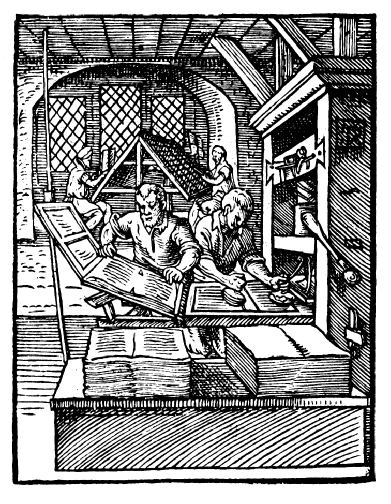
William Caxton was the first person to introduce the printing press to England. Although born in London, he learned printing in Bruges where he printed the first ever book in English. He returned to London and set up a press in Westminster in 1476.
Caxton had an immense impact on the English language. By standardizing spelling at
a time when English was still emerging from its Norman French and Anglo-
Gutenberg’s hand-
Lorem Ipsum
One of the first desktop publishing packages was Aldus PageMaker, which takes its name from Aldus Manusitus, the Venetian printer and typographer. The difference between word processing and desktop publishing is that the latter is concerned with the precise layout of text and images throughout a document such as a book.
Modern desktop publishing packages frequently use dummy text to fill pages and text
boxes in order to demonstrate how the page will look. AldusPagemaker continued this
trend by using the same place-
Lorem ipsum dolor sit amet, consectetuer adipiscing elit. Nam nibh. Nunc varius facilisis
eros. Sed erat. In in velit quis arcu ornare laoreet. Curabitur adipiscing luctus
massa.
Integer ut purus ac augue commodo commodo. Nunc nec mi eu justo tempor consectetuer.
Etiam vitae nisl. In dignissim lacus ut ante. Cras elit lectus, bibendum a, adipiscing
vitae, commodo et, dui.
Ut tincidunt tortor. Donec nonummy, enim in lacinia pulvinar,
velit tellus scelerisque augue, ac posuere libero urna eget neque. Cras ipsum. Vestibulum
pretium, lectus nec venenatis volutpat, purus lectus ultrices risus, a condimentum
risus mi et quam. Pellentesque auctor fringilla neque. Duis eu massa ut lorem iaculis
vestibulum. Maecenas facilisis elit sed justo. Quisque volutpat malesuada velit.
Steam power and the rotating drum were combined in a rotary printing press by Richard Hoe in the USA in 1843.
Modern printing still uses the rotary drum but in a modified form called offset printing.
Essentially, the image is not printed directly from the plates. It is first transferred
to a rubber-
The next revolutionary step in printing took place when Ottmar Mergenthaler invented
the Linotype machine in Germany in the mid-
The Linotype machine is ingenious. It has a keyboard that selects metal characters
that are composed into the lines of text to be printed. The term linotype comes from
“line o’ type”. These lines are used to cast a slug in a low-
The Linotype machine was gradually replaced by phototypesetting from the 1960s onward. Phototypesetting uses optical technology to produce the plates for printing and avoids the need for hot metal casting.
The Typewriter
The first practical, commercial, personal printing press was invented in 1868 by
Sholes, Glidden and Soule in Milwaukee, USA. They called their invention the Type-
Figure 1920s Underwood typewriter

Because fast typists often hit two letters almost simultaneously, two or three type heads would sometimes collide and jam, requiring you to prise them apart. Consequently, the keys on the keyboard were arranged so that letters that were frequently typed together such as ‘t’ and ‘h’ in ‘th’ were not adjacent to each other. The order of the first five keys on the back row of the typewriter was QWERTY, which is why we call the keyboard layout QWERTY today. This layout is optimum for English; French have a different layout and call their keyboard AZERTY.
Now that the problem of key-
Figure The Dvorak keyboard layout
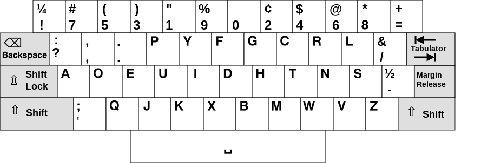
Anyone born before 1960 will remember the typewriter. However, the typewriter rapidly became obsolete during the computer revolution.
Early experiments in electrically powered typewriters took place between approximately
1870 and 1910, when the first practical electro-
IBM was one of the first companies to become involved with powered typewriters. In 1961 they launched their golf ball typewriter that used a metal sphere with all the characters embossed on its surface (see below). The sphere was rotated mechanically in two dimensions to ensure that the desired character was at the front, where it impacted the paper through the inked ribbon.
Figure The IBM Selectric print head

The golf ball typewriter did not jam and a different font could be installed by changing the sphere. The IBM Selectric was so successful that it dominated the office typewriter market for two decades.
Typewriters gradually disappeared after the 1980s, when modern computer-
The 1970s and 80s
The growth of the personal computer and microelectronics in the 1970s and 80s led
to a demand for simple, low-
Figure Output from a dot matrix printer

The print head consists of a metal block with an array of 5 x 7 tiny holes through which a wire can move. Propelling a wire through its hole (tunnel) causes it to hit the ribbon and make an inked dot on the paper. All printable characters are formed from this 5 x 7 array of dots. Each of the wires in the print head is propelled through one of the 5 x 7 holes electromechanically by means of solenoids (electromagnets).
By today’s standards the characters were crude and ugly, but the dot matrix printer
brought electronic printing to small businesses and home users. The first dot matrix
printer was introduced into the personal computer market by Epson in 1979. Over the
years print quality was gradually improved and down-
By the mid-
Printer Mechanisms
In this section, we look at today’s most popular means of printing onto paper. We are concerned largely with machines that can be used in the home or office, rather than machines that print on a commercial scale (e.g., newspapers, magazines and books).
There are several ways of creating printed text and images:
Photography: Light causes chemical reactions in certain chemicals such as silver
halides (the substance used in conventional photography). Photography is not a cost-
Thermal: Just as light causes chemical reactions, so does heat. Thermal printers
heat the surface of a specially impregnated paper to generate an image. In general,
thermal printers are now used largely for point-
Impact: Historically, this is the original form of printing as we have seen. The electric typewriter used impact printing. For several years, impact printing dominated computing with the line printer used by main frames and then the dot matrix printer used in offices and personal computing. Today, some companies still use impact printers although this technology too is fast disappearing.
Xerography: Xerography is a form of printing that uses a mixture of optical and electrostatic technologies to deposit an image in the form of dust (called toner) onto paper. The dust is attached to the paper by means of heating. This is the basic technology of the laser printer and is today’s mainstream printing mechanism.
Inkjet: The inkjet printer uses ink to form images exactly like impact printing. However, the ink is sprayed directly onto the paper by means of jets. This technology is competitive with laser technology and laser and inkjet printers compete to offer the best performance:price ratio.
Dye-
Xerography and the Laser Printer
Chester Carlson is credited with the invention of photocopying in 1930, a process he called electrophotography. His process was renamed Xerography from the Greek for dry writing, which emphasises that his technique did not use liquid chemicals, unlike other copying mechanisms.
The basis of Xerography is very simple. It is a form of photography where an image is projected onto a flat plate (today a drum is used). However, the image is recorded not in light like a photograph, but as an electrostatic charge (dark areas having the greatest charge). One of the first photoconductive materials used was the element selenium which has a high resistance in the dark and a low resistance when illuminated.
If the plate with its charged image is placed in proximity to a very fine powder (i.e., the toner), the electrostatic charge attracts the powder; the greater the charge the more the powder that is attracted. At this stage, the plate contains the image, in powder, to be printed. Finally, the plate is pressed against paper and the powder is attracted to the paper to create the final image on paper. The powder is heated to bond it with the paper to create a permanent image.
The advantage of Xerography is that it creates an entire image in one step. It does
not use impact printing which makes it potentially quiet, and there is no need to
move a print-
It took two decades before Carlson’s mechanism was implemented in a practical form. The plate was replaced by a drum coated with selenium. The drum made it easy to perform all operations during one rotation. In the 1970s IBM developed organic photoconductive materials as an alternative to selenium in order to avoid infringing Xerox’s patents on selenium.
By projecting an image on the drum as it rotates, an image is built up. Where the light is bright the selenium conducts, the charge is lost and little or no powder is picked up. Consequently, Xerography produces a positive image unlike conventional photography, where the image is initially negative and a positive image has to be made from the negative.
Because Xerography is essentially a photographic process involving an image projected onto a target, there is essentially no difference between copying and printing. In copying, the actual source image is projected (the photocopier), whereas in printing a scanning mechanism draws the image to be reproduced.
Practical Xerography uses one-
Figure 1 describes the first step in creating an image. A high voltage is applied to the insulated surface of the drum that is coated with the photoconductor. This creates a negative electrostatic charge on the surface.
Figure Charging the drum
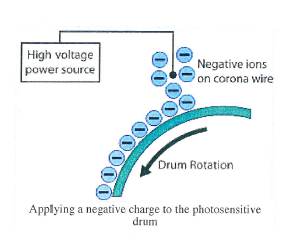
Once the drum is charged, the image to be printed is projected onto it. Figure 2 illustrates one possible scanning mechanism – there are others.
Figure Creating an image on the drum
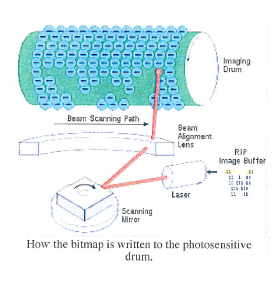
Here, the light source is a semiconductor laser. A laser is used because of its intensity and fine beam. The beam from the laser hits a rotating mirror (scanning mirror) that draws a straight line across the face of the drum. Since the intensity of the light can be controlled, a single line scan of dots (pixels) is written across the drum.
Because the drum is rotating, an image is built up from multiple scans. Since the effect of the light on the photoconduction surface is to make the surface conduct electricity, the surface charge leaks away according to the intensity of the beam hitting the surface. After a rotation, an invisible electrostatic image has been built up.
In the next stage, the latent or invisible image is developed. The surface of the drum is rotated in contact with the toner, which consists of very fine particles of a complex mixture of materials including a plastic and carbon black or some other colouring agent.
The powder, which has a positive charge, is attracted to regions of the drum that
have a high negative electrostatic charge. The attraction between drum and toner
is self-
At this point there is a positive image of the page to be printed on the drum in the form of the dry toner.
In the next stage, the image is transferred to the paper. The drum is rotated in contact with the paper and the difference in electrostatic charge causes the toner to jump from drum to paper.
Now there is a true image on the paper. However, if you were to take the paper out and rub it or blow on it, the image would disappear. In the final stage, called fusing, the image is bonded to the paper by passing it between a heated roller and a rubber roller. The heated roller is at about 200°C which fixs the final image – that’s why paper is warm when it comes from a laser printer. The fusing roller uses approximately 90% of the energy required by a laser printer and is also responsible for their relatively long warm up time.
Laser Printers – the Dangers
Operators of laser printers should be aware that there are potential hazards associated with their use. This is important in commercial applications where an organization has a legal responsibility to ensure heathy working conditions. There are two aspects of the laser printer that are of concern.
Toner: The toner is a very fine black (or other colour) powder. Toner itself is not toxic. However, toner particles can become airborne when toner is spilled or a machine jams prior to the fusing stage and the toner is lost. Toner particles might exacerbate existing conditions such as bronchitis or asthma.
Ozone: Like policemen, oxygen atoms go around in pairs; that is two oxygen atoms combine to form a stable O2 molecule. The high electrostatic voltage used in xerography can cause O2 molecules to break up. One of the liberated oxygen atoms may react with an O2 molecule to create an O3 (i.e., ozone) molecule.
Ozone is an unstable, highly-
Those who own and operate laser-
Practical machines require a further step. The drum has to be cleaned. First it is illuminated to remove any residual charge and then a brush or blade is used to remove any remaining toner which is sent to the waste toner store.
Low-
Figure The combined drum and toner cartridge

LED Printers
The term laser printer is, to some extent, generic. The basic principle of operation involves xerography using a rotating drum covered with a photosensitive material. The laser itself is not a vital part of the mechanism. Any other intense light source will do.
Some printers use LEDs (light emitting diodes) rather than laser light. These are called LED printers, although they are identical to laser printers in almost every way apart from the optics. Figure 3 illustrates the LED printer mechanism. The only difference is that a row of LEDs is used to project a line of the image onto the drum, rather than using the more complicated laser and scanning mirror.
Figure The LED printer mechanism
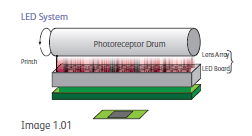
The LED array is far simpler than the laser scanning mechanism with its rotating
mirror and is more reliable. Unfortunately, it suffers from two problems: the first
is that the intensity of the individual LEDs varies (making the print quality non-
Conventional laser printers have resolutions of the order of 1200 dpi whereas mechanical offset printers (the type used to print magazines) can achieve 9600 dpi.
Printers – the Consumables
Apart from electrical energy and the paper or other material being printed, printers require consumables: toner cartridges in the case of a laser printer and ink cartridges for an inject printer.
Most printer users will have noticed that these consumables are not cheap and a set of inks (or toners) can cost a large fraction of the price of the printer itself.
Patent laws prevent competitors from directly copying printers. However, consumables
are not protected (otherwise you would have Ford gasoline for Fords and Volkswagen
gasoline for Volkswagens). Consequently, third-
Manufacturers argue that using such consumables can lead to poorer quality printing and even damage the machine. They state that their own inks (toners) are specifically developed for use with their machines and that alternate suppliers may sell products that harm the printer.
Printer manufacturers cannot prevent others from making and selling cut-
Printer manufacturers first attempted to stop competitors by including a memory chip in each cartridge that was accessed by printer software. If the printer determined that the information in a cartridge was invalid, it refused to print.
Furthermore, the printer decremented a drop counter in the cartridge’s memory chip. When the counter reached zero, the printer stopped even if you injected more ink into the cartridge.
Third party manufacturers then did the same; they added chips. The printer manufacturers responded by patenting aspects of the cartridge. Some of these patents were tested in court with the third party manufacturers arguing that the patents were invalid because they did not describe a new invention.
Grayscale Printing
A monochrome printer uses ink which has a single colour. How is it possible to print different shades of black (i.e., a grey scale) without using different ink combinations? The simple answer is that you can’t. Fortunately, you can fool the eye. The eye integrates or averages fine detail in an image. For example, if we take a square and fill 50% of its area with randomly placed black dots leaving the remaining 50% white, the square will appear as gray to the human eye as long as the resolution is fine enough.
Shades of gray can be printed by varying the ratio of black pixels to white space. A process called dithering is used to distribute the dots at random to avoid the appearance of spurious images.
Figure An illustration of gray-

The Inkjet Printer
The inkjet printer operates by painting an image using a spray of ink. The concept
is not new, but its modern implementation is. Inkjet printers operate in one of two
ways: continuous and on-
A drop-
The print head is usually quite small and has a number of nozzles so that several
drops of ink can be sprayed simultaneously. The print head is attached to a belt
which moves it across the paper from side to side. As the print head moves across
the paper, a line of the image is drawn. Then the paper is advanced and the next
line is drawn. Print head mechanisms may be uni-
There are two classes of print head, although the actual operating mechanism is generally not important to the user. Imagine a cavity containing a liquid ink with a hole in the wall. The hole is tiny; smaller than a drop of ink, so that the ink does not spontaneously leak out of the container. How do we get the drop to jump out?
Laser Forensics
Some modern laser printers and photocopiers print a fine pattern of random tiny yellow dots on the paper. This pattern is almost impossible to see and does not affect the quality of the image (see below – image taken from Wikipedia).
These dots encode the date and time of printing and the serial number of the printer. It is said that this technology was introduced as an agreement between the US government and the printer manufacturers.
Depending on who you ask, there are two reasons for this identification mechanism. Some say that it helps identify forgery. Others say that it prevents people form circulating documents anonymously.
Figure The mysterious yellow dots used to identify a printer
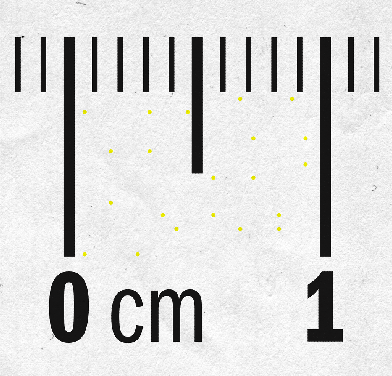
One method of creating an ink drop is to locate a heating element in the container. By passing a short pulse of electricity through the element, the ink is locally vaporized and the increase in pressure forces a drop of ink through the hole.
An alternative mechanism uses a piezoelectric crystal. When a voltage is applied across certain materials, they flex. In an inkjet printer, applying a pulse to a piezoelectric crystal causes it to suddenly change shape and send a pressure wave through the ink. This pressure wave ejects a single bubble.
Over the years inkjet technology has advanced considerably. In 1991 an inkjet nozzle was 70 m in diameter and the ink drop was 86 picolitres. In 2002 the ink drop measured 3 m and its volume was 0.1 picolitres. Note that the rate at which nozzles eject drops is in the range 5,000 to 20,000 drops/s.
Because a cartridge empties as the drops are expelled, it is necessary for air to enter to replace the lost ink. Consequently, a cartridge must have a vent to the outside atmosphere. However, it is important that the ink does not evaporate because of this vent. Some cartridges have a very long zigzag pathway between the ink chamber and the outside air to minimize evaporation.
Some inkjet printers are able to modulate (change) the size of the drops in order to produce a better result with smoother tonal gradations, especially in skin tones.
Figure Ink cartridges in an inkjet printer
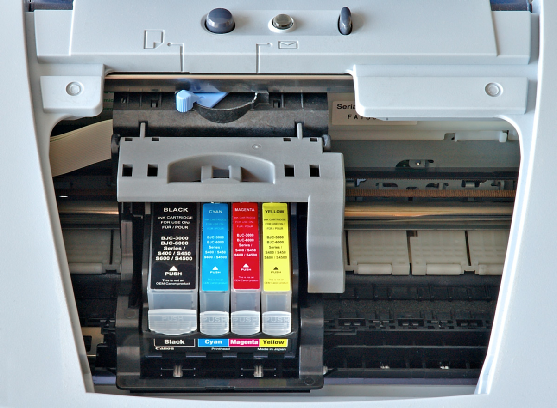
Print heads are available in two forms: a disposable cartridge that includes both
the printing mechanism and ink reservoir, or a fixed print head that does not have
an ink reservoir and is fed ink from separate reservoirs via thin plastic tubes.
A fixed print head might have as many as 7,680 nozzles (e.g., Canon PIXMA Pro9500
Mark II). The disposable cartridge is found in low-
Possibly the greatest problem faced by inkjet printer designers is nozzle clogging. The nozzles through which ink drops are propelled are open to the air and the ink in the cartridge can dry up as the solvent evaporates. This leads to clogged nozzles, especially after a long period during which the printer has been inactive.
Several anti-
Ink jet printers have advantages over impact printers and laser printers. They are cheap to manufacture, reliable, quiet in operation, have a low power consumption, and can provide a higher resolution than other printers.
The only significant disadvantage of the inkjet printer is the problem of nozzle clogging and the relatively high cost of inks.
Printers – the Total Cost of Ownership
Probably most people who buy a printer are concerned only with the its cost and its performance specifications (speed of printing, resolution, duplexing and so on). Sometimes, they may also think about the additional cost of replacement cartridges or toners.
Professional organisations and large-
Calculating the TCO of a laser printer can be more complicated than an inkjet printer because laser printers may require several consumables: the toner cartridge, the drum, the used toner collector, the fuser mechanism. Some of these are changed after 10,000 pages and some after 100,000 pages.
Printer Inks
Two types of ink are used by inkjet printers: dyes and pigment-
Pigment inks tend to be more resistant to the effects of UV light than dyes and are
therefore more colour fast; that is, they do not fade as rapidly. However, pigment-
However, pigment-
The print quality of dyes is said to be better than that of pigment-
DPI – The Confusion
There is one considerable source of confusion in the world of digital imaging and printing and that is the meaning of DPI, or dots per inch. The source of confusion is that DPI was used as a measurement of resolution in the printing industry and is sometimes used incorrectly when referring to digital images from cameras and similar devices.
Dots per inch defines the resolution of a printed image. It simply indicates the number of dots or pixels per inch along a line. It is also called PPI (pixels per inch). Note that the DPI rating of a printer may be different in the vertical and horizontal planes.
A low resolution printer (e.g., a dot matrix printer) may produce an output at 72 DPI, whereas an inkjet printer may have a typical resolution of 300 to 720 DPI. It is said that the human eye cannot resolve resolutions better than 300 DPI.
Until very recently, DPI was never applied to screen (display) resolutions. Instead,
screens were defined in terms of the absolute numbers of horizontal and vertical
pixels; for example, 1,024 x 768 (XVGA) or 1920 x 1080 (HDTV). However, Apple have
brought the term to computer and tablet displays with the introduction of their so
called Retina display, which is a way of saying, “Our display is so fine that you
cannot see the individual pixels with your naked eye.” A third-
Digital image resolution is measured in terms of pixels; for example 2000 x 1500 pixels. This resolution is not related to physical measurements and, therefore, cannot be defined in terms of DPI. If an image with 2000 pixels per line were printed on paper that is 10 inches wide, the resolution would be 2000/10 = 200 DPI. If the same image were projected onto a football field, its resolution would be only 2000/4140 = 0.48 DPI.
The confusion between pixel count and resolution becomes important when using image processing packages. Suppose you have a 5 x 7 inch photograph with a resolution of 300 DPI. This corresponds to 5 x 300 by 7 x 300 or 1500 by 2100 pixels. Now, suppose you load this 1500 x 2100 pixel images into an image processing package where the default paper size is set at 8.267” by 11.692” (i.e., A4). The package will compute the horizontal resolution as 1500/8.267 = 181.4 DPI. To some, it appears that the image quality has been reduced. It hasn’t – as long as the image is printed at 5 x 7 inches.
Colour Printing
Up to this point we have not mentioned colour and have assumed that images are printed in monochrome (i.e., black and white). Today, images can be printed in any colour and high quality photographic images produced. In order to understand how this is achieved, we need to look briefly at colour theory.
Colour is a human concept and colours are perceived by the brain.
Isaac Newton used a prism to demonstrate that white light consists of several colours. He also demonstrated that these colours could be mixed to create white light. Colour exists because of the wavelength of the light. Long wavelengths are perceived as red and short wavelengths as blue. White light can be created by mixing together red, green, and blue lights. These three colours, normally referred to as R,G,B, form the basis of the additive model of colour; that is, different colours can be created by mixing appropriate amounts of red, green, and blue. This is the basis of the electronic display found in TVs, monitors, and tablets where pixels of red, green and blue are used to create a colour image.
The following figure provides the classic three-
Figure The additive RGB colour model

Note that this standard theory of additive colour is flawed. In practice, three primary colours can be mixed to produce a complete gamut (i.e., range) of colours. This is not correct. The gamut of colours that can be produced by the RGB additive model is not the same as the gamut of colours that can be perceived by the human eye; that is, we cannot create exactly what we can see. However, this is not normally a major problem.
Printing does not use the same colour model as visible light from an illuminated display. This is because incident light and reflected light behave differently. If you see a red light from a screen, the light is red because the frequency of the light corresponds to red.
Suppose you see a surface that appears red under white light. What does that mean? The surface absorbs some components of the white light and reflects others. In this case, it absorbs all colours except red. We see red because that is what is left over when incident light is absorbed.
Printing uses subtractive colours. Instead of the red, green and blue (RGB) models of additive light, subtractive printing uses cyan, magenta and yellow, (CMY). In printing subtractive colours, yellow plus magenta gives red.
If you mix cyan, magenta and yellow pigments, all three primary colours are absorbed to give black. In practice, this black comes out as a muddy brown and real printers have to use an actual black pigment to ensure authenticity. This scheme is called CMYK, where the K indicates black. The following diagram demonstrates the effect of mixing subtractive colours.
Figure The subtractive CMY colour model
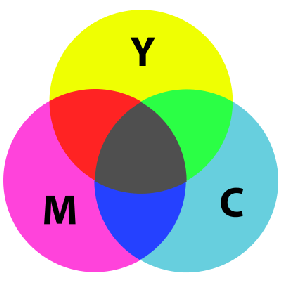
Printing Colour
Creating colour is simply a matter of mixing the three subtractive colours in the required amounts and then printing them. In reality, the colours are not mixed directly by combining inks. Instead, they are printed successively to build up an image. This means that three (or four if you are using black) images have to be built up.
The Colour Laser Printer
The colour laser printer requires four separate images to be built up on four drums, one for each of the subtractive colours and black). Each of these drums is then used to transfer the appropriate toner colour to the paper. This mechanism increases the cost of colour laser printers over its monochrome counterpart. Moreover, it is necessary to ensure that each of the four images is exactly positioned over the paper; otherwise the final image will be defective due to the separation of individual colours. Ensuring that all colours are printed in the correct position is called registration. Some colour laser printers print the four images onto a rubber belt first and then transferred them to the actual paper (a little like offset printing).
Inkjet Colour Printer
The step from monochrome to colour inkjet is much simpler than from monochrome laser printer to colour laser printer. All that is necessary is that the print head must have nozzles with colour inks as well as black ink.
Low-
Some printers also include a clear gloss ink that is sprayed over the ink in order to create a glossy finish.
The Epson Pixma PRO-
Photo Black
Matte Black
Dark Grey
Grey
Light Grey
Cyan
Photo Cyan
Magenta
Photo Magenta
Yellow
Red
Chroma Optimiser
Paper for Printers
Both laser and inkjet printers print text and image on paper. However, the optimum type of paper is not the same for both printers, because each type uses a different print mechanism. Laser printers use a fine powder that is bonded with the paper and inkjet printers spray wet ink drops that dry on the paper.
Because inkjet printers are currently capable of better resolution and colour fidelity than laser printers, the nature of the paper is more important if the maximum quality image is to be achieved. The surface of the paper has to be coated with an absorbent material that holds the ink but which does not let it spread out.
High quality photo paper intended for printing images on an inkjet printer uses several layers of coatings to achieve the required properties.
Standard office paper is not recommended for inkjet printers because wet inks tend to wick through the fibres and spread out, increasing the size of the dot beyond its normal diameter.
Solid Ink Printers
The solid ink printer offers an alternative to inject and laser printers, although
it has a much smaller share of the printer market. Solid ink technology operates
on a similar principle to inkjet technology, except that it uses sticks of solid
ink that are melted before printing. The ink is ejected via nozzles using piezoelectric
drop-
The principal claim of solid ink is that it provides very vibrant colours. Since
the inks are made from a waxy material they can produce a high-
The print head of a solid ink printer is fixed and does not scan the paper. The ink is melted at about 100°C inside the mechanism and cools between periods of use. The nozzles are not subject to the type of clogging that plagues inkjet printers, although clogging can occur due to impurities or even dust contamination.
Solid ink technology operates like offset printing; that is, the ink is not applied directly to the paper. The melted ink is applied to a transfer drum and that drum is pressed against the paper to create the image. The liquid ink is solid before application to the paper and does not spread out or smear on the paper. Moreover, because the print head to drum distance is constant (print head to paper is more variable), the print quality is more constant.
Solid ink printers are as fast as laser printers.
However, the ink must be melted before use and kept molten during the standby period
using more power than an inkjet. Inkjet printers should not be physically moved until
about 30 minutes has elapsed after their last use. Finally, if the print head does
become clogged, the media-
Solid ink printers use the subtractive CMYK model and have four inks.
Solid ink printers have several advantages such as high reliability, excellent quality
output, and speed. However, they are more expensive than laser printers and there
are no very low-
Electrical Interface
Printers can be connected to computers or they can be networked. Over the years,
computer-
In the 1970s and 1980s there were two popular printer interfaces; the serial interface
and the parallel interface. The serial interface was the RS232C interface designed
for connecting computers to modems for data transmission via the telephone line.
This interface was never intended for printer use and was slow and inefficient. It
had to be configured for each computer printer pair. Moreover, it was designed to
transmit ASCII-
Note that a printer interface should be bidirectional in order for the computer to receive messages from the printer, such as “out of paper”, paper jam”, etc.
The parallel printer interface, also known as the Centronics interface, uses a 36-
The old serial and parallel interfaces were replaced by the USB, universal serial
bus. This is a low-
Virtually, all consumer printers today use a USB interface. Some higher end printers also provide an Ethernet interface which allows the printer to be treated as a networked device that can be accessed by any computer connected to the same network. This permits sharing of printers in an office environment.
Some modern printers now include a wireless interface that provides the same facilities as an Ethernet cable connection, except that you don’t have to route cables round the building. This is a blessing in the home environment. Wireless connections can use either Bluetooth or IEEE 802.11 (WiFi) interfaces.
Printer interfaces are dominated today by USB, Ethernet, and WiFi. However, it is possible, but relatively rare, to use IEEE 1394 Firewire (a close relative of USB) or SCSI (the Small Computer System Interface). These two interfaces are relatively obsolete and we do not need to consider them further.
Printer Languages
The information required to specify the text or an image to be printed must be transferred
from the computer to the printer. In the early days of the printer, information was
transmitted as ASCII-
Page description languages, PDLs, were developed to control the printer directly and make it possible to handle different fonts and to print images as well as text. You could say that a page description language transfers some of the effort of printing an image from the computer to the printer (in the same way that a graphics card takes over image processing from the CPU).
Hewlett-
One of the most popular page description languages is PostScript that was developed
in 1982 by Adobe Systems. The Apple LaserWriter was the first commercial printer
to incorporate PostScript in 1985. PostScript processing requires a considerable
amount of computer power, which adds to the cost of the printer. For some time, PostScript
printers were more expensive than non-
Most printers include printer driver software that translates the image from the user application into a form that can be interpreted by the printer. The difference between a printer driver and a standard page description language is that the printer driver is intended for one specific printer, whereas the PDL is universal and can be used by any printer with the same PDL interpreter.
Printer Specifications
Here are two typical (partial) printer specifications, to give you an idea of the current capabilities. One is inkjet and the other laser.
Canon PIXMA iP7250
This is a colour inkjet printer intended for home use. It uses five inks (two blacks) and produces photo quality output.
Print resolution: 9600 x 2400 dpi (maximum)
Interface: USB 2.0, WiFi IEEE 802.11 b/g/n,
Inks: Five ink tanks (black, pigment black, cyan, magenta, yellow)
Speed: 15 ppm (mono), 10 ppm (colour), 21 seconds for a 10cm x 15cm colour print)
Printing modes: borderless and duplex (two-
Paper handling: Lower cassette Plain paper 64 – 105 g/m2, photopaper to 300 g/m2.
Weight and dimensions: 6.6 kg, 451 x 368 x 128 mm
Power: 0.3W (off), 2.1W (stand-
HP LaserJet Enterprise 500 colour M551dn
This is a colour laser printer intended for office use. It uses five inks (two blacks) and produces photo quality output.
Print resolution: 1200 x 1200 dpi (max)
Interface: USB 2.0, Gigabyte Ethernet
Print languages: PCL 6, HP PostScript Level 3 emulation, native PDF
Toners: Four (black, cyan, magenta, yellow)
Speed: 32 ppm (mono), 32 ppm (colour), 29 ppm (duplex)
Printing modes: duplex (two-
Paper handling: Tray 100 sheets 60 – 220 g/m2, Tray 2 500 sheets 60 – 220 g/m2
Weight and dimensions: 34.6 kg, 514 x 491 x 402 mm
Power: 0.3W (off), 51 W (stand-
Printer Terminology
Duplex
Printers with a duplexing mechanism have the ability to print on both sides of the
paper. This provides a more efficient use of paper and smaller multi-
Paper Weight
Paper can be expressed by its dimensions and its weight. In the metric system the weight of paper is expressed as its weight in grams per square metre; for example, the weight of typical A4 paper for office use is 80 g/m2. In the USA weight is sometimes expressed as the weight in imperial units of a ream of 500 sheets of the paper; for example, typical letter size (11 inches by 8.5 inches) paper has a weight of 5 lbs per ream.
Print speed
The print speed of a printer is expressed as pages per minute. Sometimes the speed is given as the reciprocal, which is the time to print a sheet. The printing time is determined by the print mode (monochrome/colour) and several other factors, depending on the printer mechanism. There is no universal definition of the paper size used in evaluating print speed. Consequently, a printer’s published print speed may not be a reliable indicator of the printer’s performance.
The Future
The American baseball player Yogi Berra once said, “It’s tough to make predictions, especially about the future.” That’s certainly true about printing. What can we expect?
Some pundits predict the death of printing because of the near universality of digital media, particularly the tablet and cell phone. Even aircraft boarding passes are becoming obsolete because of the ability of smart phones to display boarding details and of the security checkpoint to read the cell phones. Even so, I do not think that printed media will vanish in the near future.
It seems that in the short term we can expect progress in the design of inkjet printers.
They are already low-
HP has produced its PageWide technology that uses a print head as wide as the media
which means it is no longer necessary to scan a line with a moving head. A line-
Consumer printers have over the last few years have developed into all-
Digital paper (or E-
It is possible that future generations of digital paper with become even thinner
and approach some of the properties of real paper (fold-
Choosing a Printer – the Questions
Here we summarize the printer by listing the decisions that have to be made by anyone buying or specifying a printer:
Technology Inkjet, laser, solid ink, thermal, impact
Colour Monochrome or colour
Cost Purchase price or cost of leasing
Cost of running Ink/toner, paper, consumables, power
Size and weight Portability
Reliability Total cost of ownership
Noise In standby and operating modes
Speed Pages per minute
Speed Start-
Quality Resolution, tonal range, colour accuracy
Media Range of paper weights, thicknesses, finishes and surfaces
Media size A4, A3 letter, etc.
Trays Capacity of media trays and bins
Interface Parallel, serial, WiFi, Ethernet, direct flash memory
Software Device driver and additional packages
Support Manufacturer, third-
Environment Ambient temperature, humidity, air pressure – for airborne
applications
Questions
Q1
It is widely reported that inkjet and laser printer manufacturers sell their printers at artificially low prices, but sell their consumables (ink, toner) at very high prices. Suppose that the manufacturers were to increase the cost of printers and reduce the cost of consumables so that the two changes balanced each other.
How do you think that this would affect the printer market?
Q2
Your digital camera takes an image that is composed of 6 Megapixels. The aspect ratio of the image is 3:2 (aspect ratio is the ratio of horizontal to vertical dimensions). Suppose you are going to print this on A4 paper. This image is laid out in landscape mode and the A4 in portrait mode. What is the maximum resolution, DPI, you can print the image?
Lorem Ipsum
One of the first desktop publishing packages was Aldus PageMaker, which takes its name from Aldus Manusitus, the Venetian printer and typographer. The difference between word processing and desktop publishing is that the latter is concerned with the precise layout of text and images throughout a document such as a book.
Modern desktop publishing packages frequently use dummy text to fill pages and text
boxes in order to demonstrate how the page will look. AldusPagemaker continued this
trend by using the same place-
Lorem ipsum dolor sit amet, consectetuer adipiscing elit. Nam nibh. Nunc varius facilisis
eros. Sed erat. In in velit quis arcu ornare laoreet. Curabitur adipiscing luctus
massa.
Integer ut purus ac augue commodo commodo. Nunc nec mi eu justo tempor consectetuer.
Etiam vitae nisl. In dignissim lacus ut ante. Cras elit lectus, bibendum a, adipiscing
vitae, commodo et, dui.
Ut tincidunt tortor. Donec nonummy, enim in lacinia pulvinar,
velit tellus scelerisque augue, ac posuere libero urna eget neque. Cras ipsum. Vestibulum
pretium, lectus nec venenatis volutpat, purus lectus ultrices risus, a condimentum
risus mi et quam. Pellentesque auctor fringilla neque. Duis eu massa ut lorem iaculis
vestibulum. Maecenas facilisis elit sed justo. Quisque volutpat malesuada velit.
Laser Printers – the Dangers
Operators of laser printers should be aware that there are potential hazards associated with their use. This is important in commercial applications where an organization has a legal responsibility to ensure heathy working conditions. There are two aspects of the laser printer that are of concern.
Toner: The toner is a very fine black (or other colour) powder. Toner itself is not toxic. However, toner particles can become airborne when toner is spilled or a machine jams prior to the fusing stage and the toner is lost. Toner particles might exacerbate existing conditions such as bronchitis or asthma.
Ozone: Like policemen, oxygen atoms go around in pairs; that is two oxygen atoms combine to form a stable O2 molecule. The high electrostatic voltage used in xerography can cause O2 molecules to break up. One of the liberated oxygen atoms may react with an O2 molecule to create an O3 (i.e., ozone) molecule.
Ozone is an unstable, highly-
Those who own and operate laser-